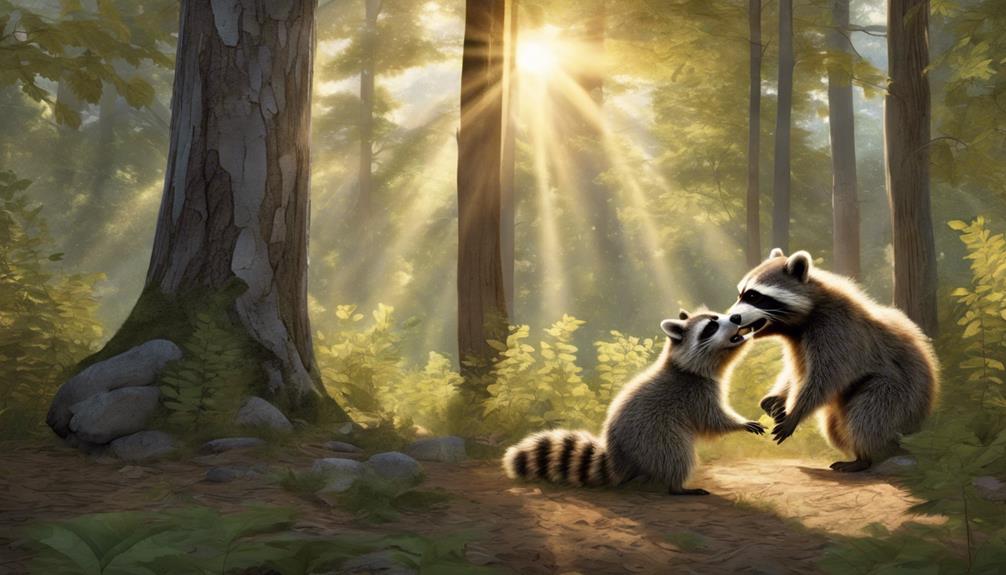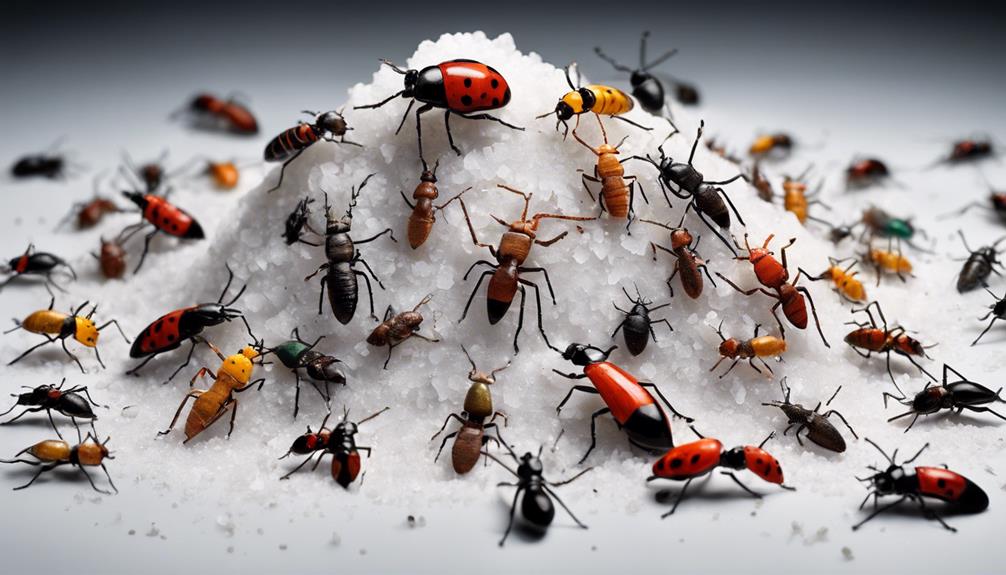Raccoons and bears belong to the same Carnivora order, sharing genetic ties and a common ancestor. They both display problem-solving skills and adaptability, though bears are more solitary than raccoons. Bears, larger and heavier, have different builds from raccoons, known for their compact physique. Conservation efforts are essential for their coexistence and ecosystem balance. By understanding their interactions and distinct roles, conservation strategies can be tailored effectively. Resource partitioning minimizes direct competition, and studying their genetic makeup sheds light on their evolutionary history. Their relationship reveals intriguing insights into the dynamic world of carnivores.
Key Takeaways
- Genetic analysis reveals shared DNA and evolutionary family connections.
- Both species exhibit problem-solving skills and opportunistic feeding habits.
- Raccoons display social interactions, while bears tend towards a solitary lifestyle.
- Coexistence strategies aid in navigating shared territories and resources.
- Understanding shared genetic similarities provides insights into evolutionary paths and adaptations.
Evolutionary Background
In exploring the evolutionary background of raccoons and bears, we investigate their shared lineage within the Carnivora order. These two fascinating creatures, despite belonging to different families, trace their roots back to a common ancestor within the Carnivora order.
The Carnivora order encompasses a diverse group of mammals known for their meat-eating habits and includes a wide range of species, from the mighty polar bear to the cunning raccoon.
Studying the evolutionary relationship between raccoons and bears provides insights into how these animals have adapted and evolved over time to thrive in various environments.
Shared Behavioral Traits
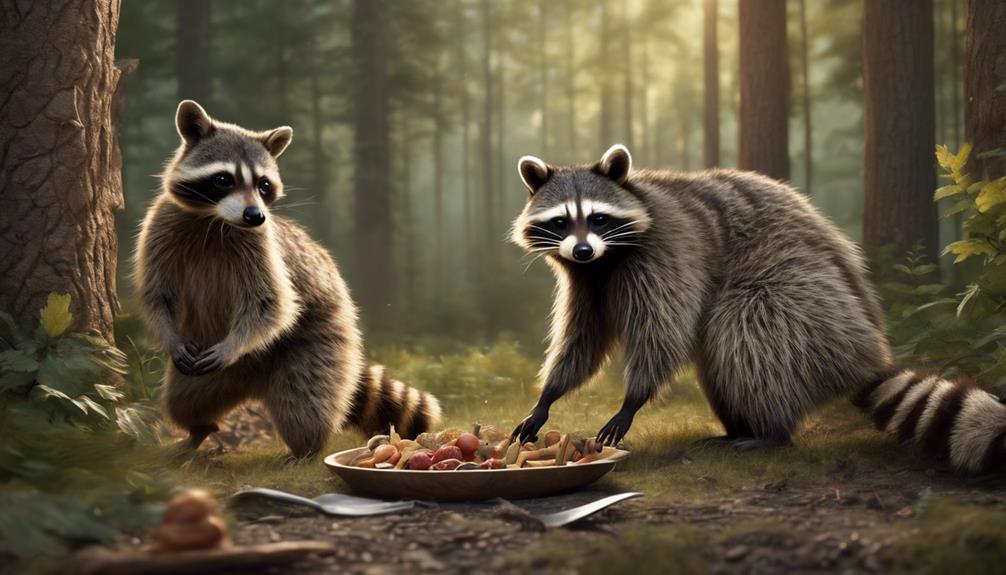
Demonstrating problem-solving skills and opportunistic feeding habits, raccoons and bears exhibit shared behavioral traits within their respective families. Both species showcase a remarkable ability to adapt to diverse environments, utilizing their intelligence to overcome challenges in securing food sources. While bears lean towards a more solitary lifestyle, raccoons display a higher inclination towards social interactions and group behaviors, reflecting the varying social structures within the Procyonidae and Ursidae families. These behavioral distinctions between raccoons and bears underscore the unique adaptations each species has developed within their shared family classification.
Furthermore, the social flexibility and adaptability observed in both raccoons and bears highlight their capacity to adjust their behaviors based on environmental factors and resource availability. Understanding these shared behavioral traits not only enhances our appreciation for the diversity within the family of Procyonidae and Ursidae but also sheds light on the intricate ecological roles these animals play in their respective habitats.
Genetic Similarities Unveiled
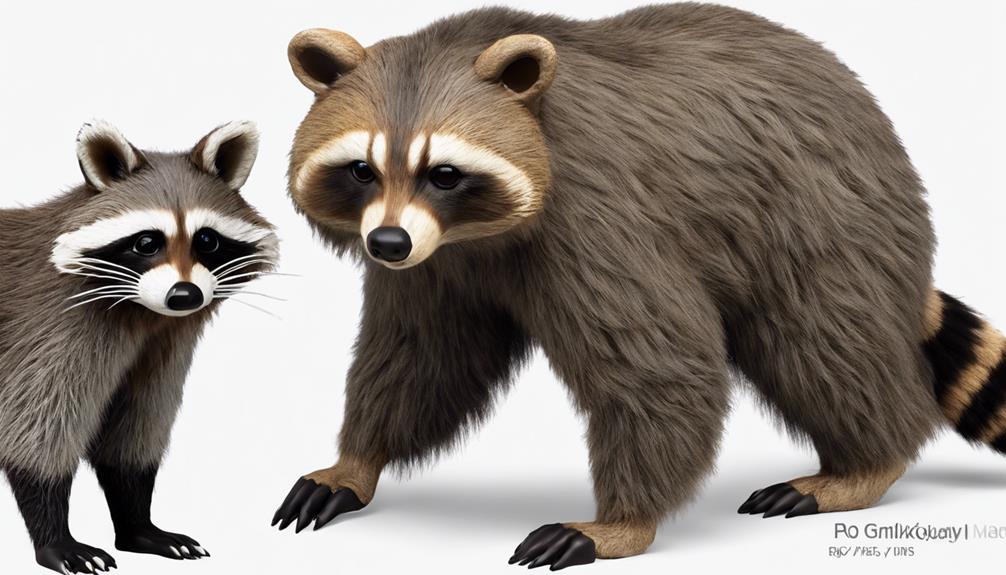
Genetic analysis has revealed captivating discoveries about the relationship between raccoons and bears, exposing shared DNA and evolutionary family connections. These shared genetic similarities hint at a common ancestry that links these creatures within the same family tree.
Molecular studies have been instrumental in unraveling the intricate genetic connections that bind raccoons and bears together.
Shared DNA Discoveries
Amidst the domain of genetic analysis, a surprising disclosure emerges – a close relationship between raccoons and bears has been revealed through shared DNA discoveries. The genetic similarities found in the DNA sequences of raccoons and bears point towards a common evolutionary history, showcasing a deep familial bond between these seemingly distinct animals. To illustrate this connection further, consider the following table:
| Genetic Similarity | Common Ancestry | Evolutionary Bond |
|---|---|---|
| Shared DNA markers | Ancestor species | Adaptation linkage |
| Overlapping sequences | Evolutionary divergence | Familial relationship |
| Molecular studies | Ancestral connections | Genetic affinity |
These shared DNA discoveries not only shed light on the genetic ties between raccoons and bears but also provide valuable insights into their evolutionary paths and adaptations.
Evolutionary Family Connections
In exploring the evolutionary family connections between raccoons and bears, a remarkable closeness is revealed through shared genetic similarities. Through genetic analysis, we uncover a deep genetic connection that signifies a closer relationship than previously believed. This sheds light on their common ancestry and evolutionary history, providing insights into their shared genetic traits and adaptations.
The genetic connection between raccoons and bears highlights their common ancestry and evolutionary history. Understanding the evolutionary family connections between raccoons and bears provides insights into their shared genetic traits and adaptations. Evolutionary studies reveal shared genetic similarities between raccoons and bears in the Procyonidae and Ursidae families.
Anatomical Comparisons
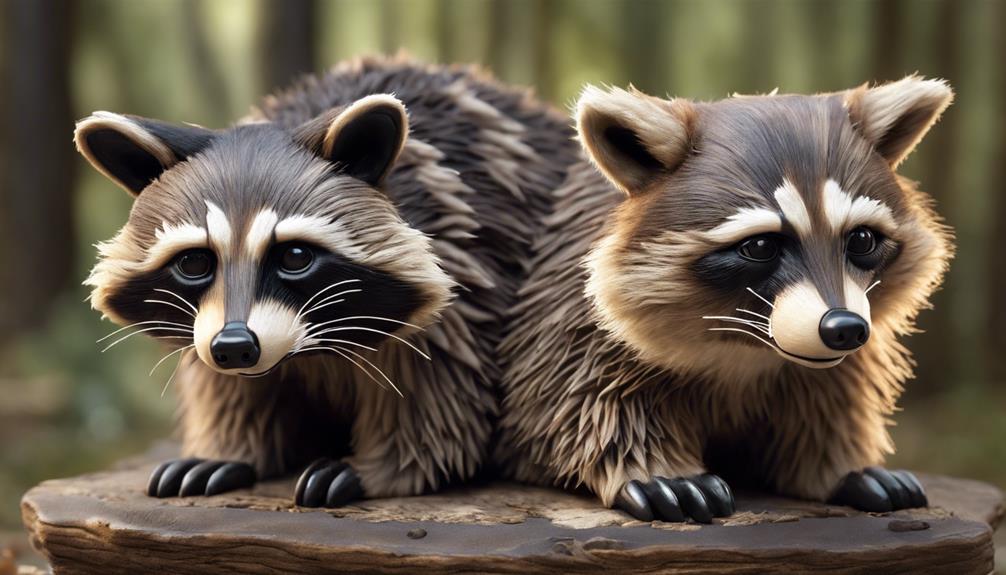
When comparing raccoons and bears anatomically, it's fascinating to observe differences in size and proportions. Bears boast larger bodies and skeletal structures, while raccoons exhibit a more compact physique.
These distinctions in size and skeletal features play a vital role in how each animal navigates and thrives in its respective environment.
Size and Proportions
Comparing the sizes and proportions of raccoons and bears reveals distinct anatomical differences highlighting their respective adaptations for survival and ecological roles. When we investigate their anatomical variances, we can observe:
- Bears boast larger sizes, with the formidable Kodiak bear weighing up to 1,500 pounds, while raccoons are more petite, weighing between 4 to 26 pounds.
- Raccoons exhibit a slender physique with a long, bushy tail, ranging from 16 to 28 inches, whereas bears have a robust build with a shorter tail, measuring 5 to 10 feet in length.
- The proportions of a bear's body are tailored for strength and power, featuring strong limbs and a massive head, contrasting raccoons' agile bodies, perfect for climbing and deftly manipulating objects with their nimble hands.
Skeletal Structure
Pivoting from the discussion on size and proportions, the skeletal structures of raccoons and bears exhibit notable similarities due to their shared classification in the order Carnivora. Bears belong to the Ursidae family, while raccoons are part of the Procyonidae family, making them distant cousins in the vast Carnivora order.
Both species possess long bones, specialized teeth for carnivorous diets, and joint articulations that aid in their predatory behaviors. Bears showcase larger skulls and robust jaws, reflecting their powerful hunting capabilities compared to the more agile raccoons.
Raccoons, on the other hand, display adaptations for climbing with their limb proportions and paw anatomy, emphasizing their arboreal lifestyle. These anatomical comparisons between raccoons and bears underscore their evolutionary adaptations for distinct ecological niches within the Carnivora order.
Family Lineage Insights
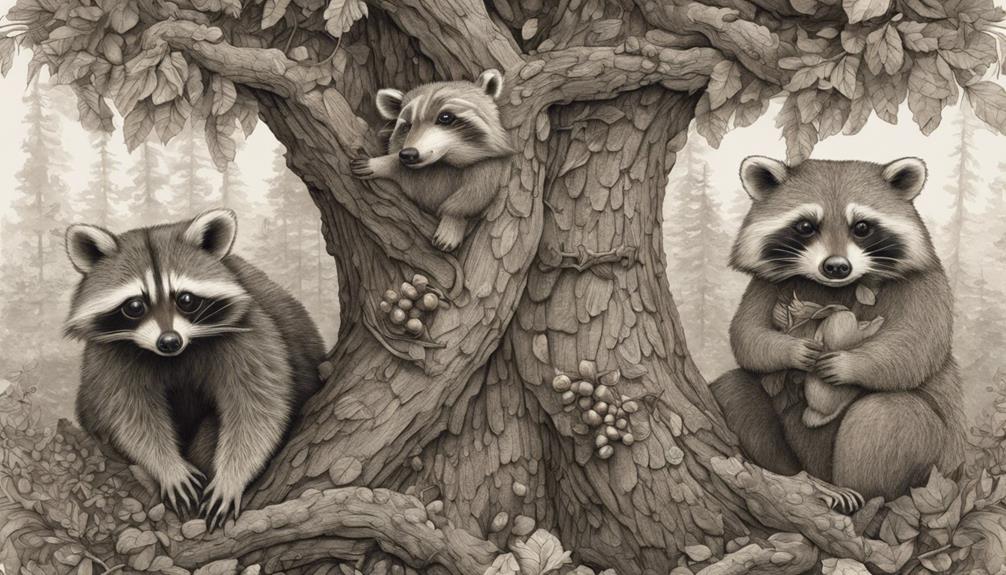
Exploring the family lineage of raccoons and bears sheds light on their shared evolutionary history and distinct characteristics within the Carnivora order. The Procyonidae family, to which raccoons belong, and the Ursidae family, home to bears, have a common ancestry despite their current separation. Understanding this lineage provides insight into the evolutionary paths that led to the unique traits, behaviors, and adaptations of these fascinating animals.
- Shared Ancestry: Raccoons and bears share a common evolutionary lineage within the Carnivora order.
- Divergence: The Procyonidae family, including raccoons, diverged from the Ursidae family, which includes bears, at a specific point in evolutionary history.
- Distinct Characteristics: Family lineage insights offer valuable information on the distinct characteristics that define raccoons and bears within the Carnivora order, illustrating how their shared ancestry shaped their individual traits.
Coexistence in Ecosystems
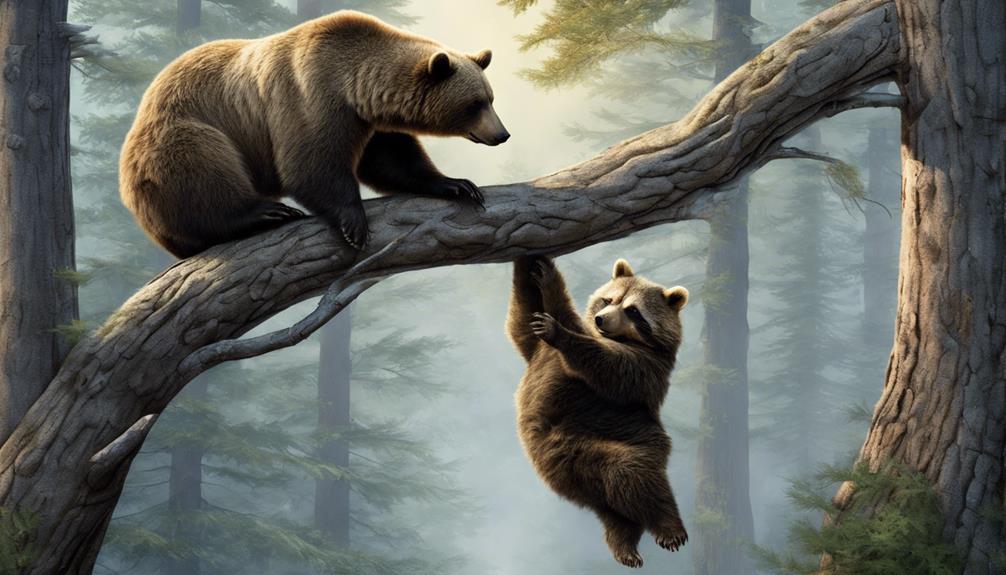
In understanding the coexistence of raccoons and bears in ecosystems, we uncover the intricate dynamics of harmony that sustain these diverse creatures.
By employing strategies that offer mutual benefits, raccoons and bears navigate the challenges of sharing territories and resources.
Addressing coexistence challenges helps these animals thrive in their respective habitats and contributes to the overall balance of the ecosystem.
Ecosystem Harmony Dynamics
How do raccoons and bears maintain ecosystem harmony through their distinct roles and interactions? These two species contribute to ecosystem balance by fulfilling specific niches and adapting to shared habitats. Here is how they do it:
- Foraging Habits: Raccoons, as omnivorous scavengers, clean up leftover food, while bears, as large predators, help control certain animal populations.
- Minimized Competition: Raccoons and bears utilize diverse food sources, reducing direct competition and allowing both species to coexist peacefully.
- Conservation Impact: Understanding their interactions aids conservation efforts, ensuring the protection of these species and their habitats.
Mutual Benefit Strategies
Raccoons and bears employ mutual benefit strategies to coexist harmoniously within ecosystems, showcasing their adaptability and resource utilization. In the family Procyonidae, these species navigate their shared habitats by practicing resource partitioning, where each utilizes distinct resources to minimize competition.
Bears, with their large size and dominance, access resources like fruits and nuts that are challenging for raccoons to obtain. In contrast, raccoons, known for their agility and intelligence, thrive in areas where bears may struggle, such as climbing trees for eggs or hunting smaller prey. This division of resources allows both species to coexist without direct conflict, highlighting the intricate balance of nature and the benefits of cooperation in maintaining ecosystem health.
Coexistence Challenges Addressed
Coexisting in shared ecosystems poses both raccoons and bears with challenges that arise from competition for food and resources. To address these coexistence challenges:
- Resource Partitioning: Raccoons and bears can divide up their habitat by utilizing different areas or foraging at distinct times to reduce direct competition.
- Behavioral Adaptations: Raccoons demonstrate flexibility in their behavior, adjusting to minimize conflicts with intimidating bears and ensuring survival.
- Ecosystem Dynamics: Understanding the intricate interactions between raccoons and bears sheds light on the complex web of relationships within ecosystems, showcasing the innovative strategies species employ for coexistence.
Conservation Concerns Addressed
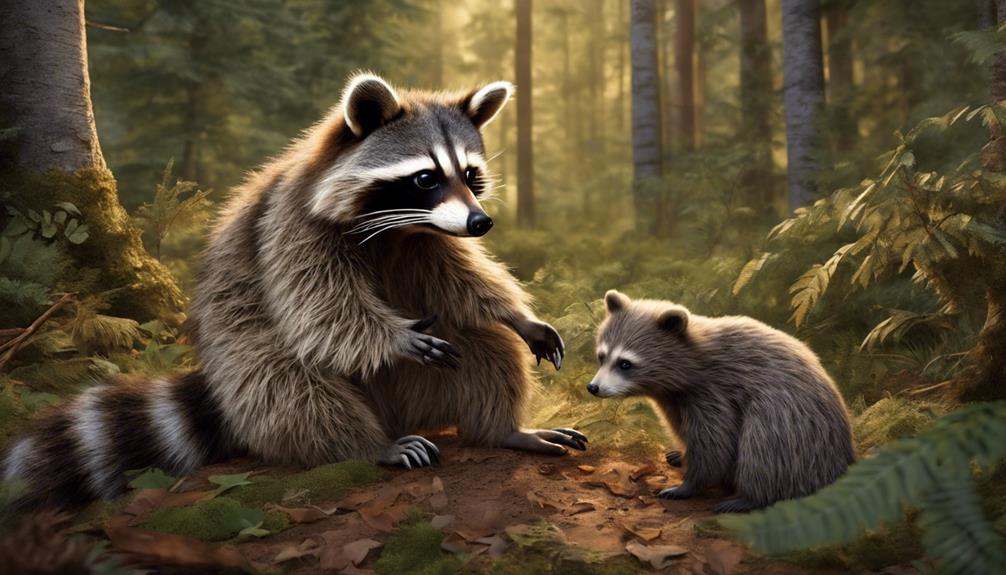
Amidst growing threats like habitat loss and hunting, conservation efforts play an essential role in safeguarding the well-being of raccoons and bears. These efforts are vital to guarantee the survival of both species in the face of increasing challenges. Bears, some of which face endangerment, require specific conservation measures to protect their populations. Similarly, although raccoons are generally abundant, they still need protection to thrive in their natural habitats.
Conservation initiatives not only focus on individual species but also aim to protect biodiversity and preserve the ecological roles that raccoons and bears play within their ecosystems. By addressing conservation concerns surrounding these animals, we can contribute to the overall health of our environment. The conservation status of both raccoons and bears is a pressing issue for wildlife experts and conservationists, highlighting the importance of taking action to safeguard these iconic creatures for future generations.
Habitat Overlaps Explored

Exploring the shared habitats of raccoons and bears reveals intriguing insights into their ecological interactions and resource utilization. In forests, wetlands, and mountainous regions across North America, these species coexist, maneuvering the complex dynamics of their overlapping territories.
- Diverse Landscapes: Raccoons and bears adapt to a variety of environments, from urban areas to remote wilderness, showcasing their ability to thrive in diverse landscapes.
- Competition for Resources: In areas where raccoons and bears share habitats, competition for food and shelter may arise, highlighting the importance of understanding their ecological interactions.
- Impact of Habitat Loss: Human development and deforestation have contributed to habitat loss, leading to increased encounters between raccoons and bears, underscoring the need for effective conservation and management strategies to preserve these valuable ecosystems.
Adaptations for Survival
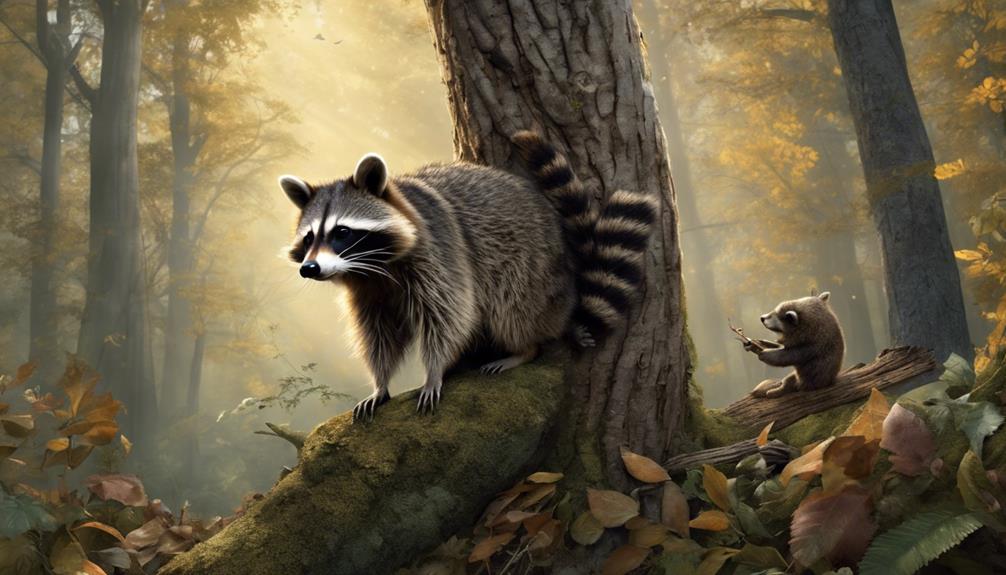
How do raccoons and bears' diverse adaptations contribute to their survival in various habitats?
Both raccoons and bears have evolved unique traits that enhance their ability to thrive in different environments. Raccoons, with their nimble hands and problem-solving skills, excel at finding food and shelter in varied landscapes. Their social flexibility allows them to adapt to changing circumstances by engaging in communal behaviors.
Bears, on the other hand, rely on their physical strength and hunting prowess to survive. Their ability to hibernate during winter helps conserve energy when food is scarce, showcasing a distinct survival strategy.
Despite these differences, the shared ancestry of raccoons and bears highlights the versatility within the same family. Through distinct evolutionary paths, these creatures have developed adaptations that suit their specific needs, leading to their continued survival and success in the wild.
Future Research Prospects

To further comprehend the evolutionary relationship between raccoons and bears, exploring their genetic similarities and differences holds promise for future research prospects.
- Genetic Similarities: Investigating the genetic makeup of raccoons and bears can reveal common ancestry and evolutionary patterns, shedding light on how these species diverged and adapted to different ecological niches.
- Ecological Roles: Understanding the specific roles that raccoons and bears play in their shared habitats can provide vital insights into their interactions, resource utilization, and potential competition for food and territory.
- Behavioral Responses: Studying how raccoons and bears respond behaviorally to environmental changes, such as human disturbances or alterations in their surroundings, can help conservationists tailor management strategies to safeguard the well-being of both species.
Frequently Asked Questions
What Is the Bear's Closest Living Relative?
The bear's closest living relative is the raccoon. Molecular analysis indicates a closer connection than previously thought. Both share a common ancestry within the Carnivora order. Studying their relationship aids in understanding shared traits.
What Animals Are Raccoons Most Closely Related To?
Raccoons are most closely related to bears, sharing a common ancestor within the Ursidae family. Molecular analysis shows a closer relationship than physical traits suggest. Understanding their genetic ties illuminates shared ancestry and adaptations.
What Animals Are in the Same Family as Polar Bears?
In the same family as polar bears are various bear species like grizzly bears, black bears, and sun bears. They share common characteristics and evolutionary history, belonging to the diverse Ursidae family of carnivorous mammals.
Are Pandas More Closely Related to Bears or Raccoons?
Pandas are genetically closer to bears than raccoons. This surprising fact showcases the intricate links within the Ursidae family, sparking curiosity about the evolutionary path that led to pandas being firmly classified among bears rather than raccoons.
Are Raccoons and Bears Related or Are They Completely Different Species?
Raccoons and bears share some similarities in their appearance but they are completely different species. Their evolutionary history and biological characteristics set them apart. Understanding raccoons and bears difference can help in identifying their behaviors and habitat preferences. It’s crucial to recognize their distinct traits for conservation and wildlife management efforts.
Conclusion
To sum up, the captivating relationship between raccoons and bears in the same family unveils a nuanced and intricate connection that goes beyond mere genetic similarities.
Through shared behavioral traits, anatomical comparisons, and habitat overlaps, these two species have adapted to survive in their respective environments.
As we continue to explore this relationship, we gain valuable insights into the interconnectedness of the animal kingdom and the importance of conservation efforts to protect these unique creatures.
